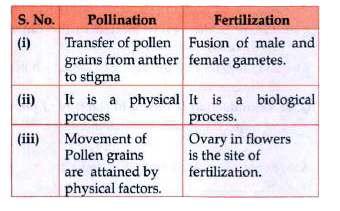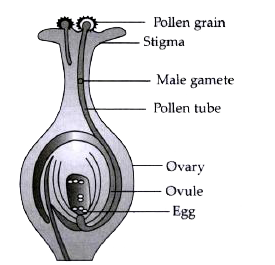Distinguish between pollination and fertilisation. Mention the site and product, of fertilisation in a flower. Draw a neat, labelled diagram of a pistil showing pollen tube growth and its entry into the ovule.
Topper's Solved these Questions
- REPRODUCTIONBOOK - OSWAL PUBLICATIONCHAPTER - REPRODUCTIONEXERCISE - BOARD CORNER (Very Short Answer Type Question)
3 Videos
- REPRODUCTIONBOOK - OSWAL PUBLICATIONCHAPTER - REPRODUCTIONEXERCISE - BOARD CORNER (Short Answer Type Question)
16 Videos
- REPRODUCTIONBOOK - OSWAL PUBLICATIONCHAPTER - REPRODUCTIONEXERCISE - NCERT EXEMPLAR (MULTIPLE CHOICE QUESTIONS)
27 Videos
- OUR ENVIRONMENTBOOK - OSWAL PUBLICATIONCHAPTER - OUR ENVIRONMENTEXERCISE - BOARD CORNER ( SHORT ANSWER TYPE QUESTIONS)
8 Videos
- SUSTAINABLE MANAGEMENT OF NATURAL RESOURCESBOOK - OSWAL PUBLICATIONCHAPTER - SUSTAINABLE MANAGEMENT OF NATURAL RESOURCESEXERCISE - CREATING BASED QUESTIONS
3 Videos
Similar Questions
Distinguish between pollination and fertilization. Mention the site and the product of fertilization in a flower.
View SolutionDraw a labelled diagram of the longitudinal section of a pistil showing pollen germination .
View SolutionDraw a well-labelled diagram of a mature ovule, showing its internal structure.
View SolutionDraw a neat labelled diagram showing energy levels and transition between them for hydrogen atom.
View SolutionDraw a neat labelled diagram showing forces acting on the meniscus of water in a capillary tube.
View SolutionDraw a neat labelled diagram showing forces acting on the meniscus of water in a capillary tube.
View SolutionWhat is 'double fertilisation'? Describe it with the help of a neat and well labelled diagram. Give its importance.
View Solution(a) Draw a diagrammatic sectional view of a mature anatropous ovule and label the following parts in it :
(i) that develops into seed coat.
(ii) that develops into an embryo after fertilization.
(iii) that develops into an endosperm in an albuminous seed.
(iv) through which the pollen tube gains entry into the embryo sac.
(v) that attaches the ovule to the placenta.
(b) Describe the characteristic features of wind pollinated flowers.
View SolutionDistinguish between forced vibrations and resonance. Draw neat, labelled diagrams for the modes of vibration of a streched string in second harmonic and third harmonic.
The area of the upper face of a rectangular block is 0.5m×0.5m and the lower face is fixed. The height of the block is 1cm. A shearing force applied at the top face produces a displacement of 0.015mm. Find the strain and shearing force.
(Modulus of rigidity : η=4.5×1010N/m2)
View SolutionAnswer question the basis of your understanding of the following paragraph and the related studied concepts :
After fertilisation, the zygote divides several times to form an embryo within the ovule. The ovuile develops a tough coat and is gradually converted into a seed. The ovary grows rapidly and ripens to form a fruit. Meanwhile, the petals, sepals, stamens, style and stigma may shrivel and fall off. The seed contains the future plant or embryo which develops into a seedling under appropriate conditions. This process is known as germination.
Draw a well-labelled diagram to show future shoot and future root in a seed.
View Solution

